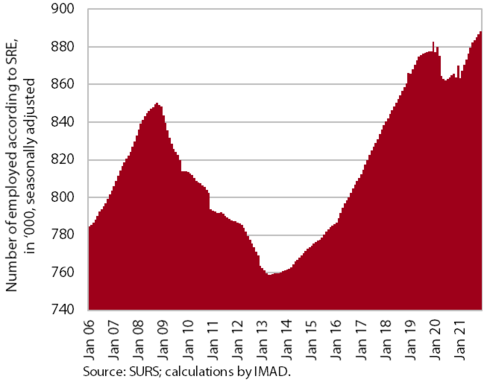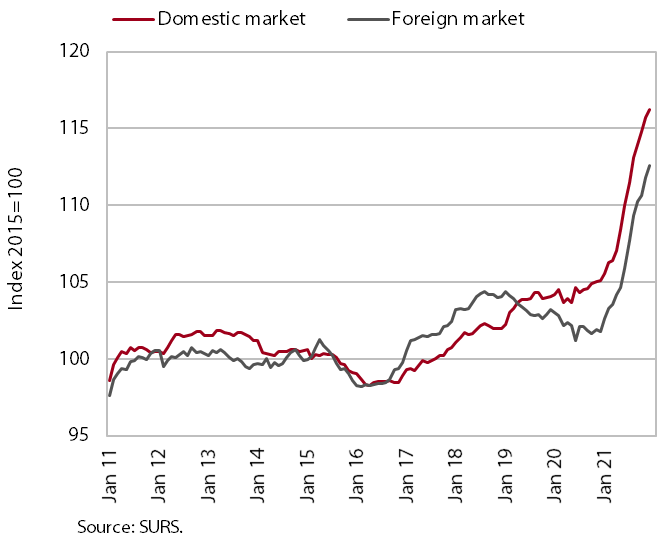Charts of the Week
Current economic trends from 17 to 21 January 2022: labour market and Slovenian industrial producer prices
Labour market conditions remained favourable last November and employment continued to rise. In the first 11 months of last year, employment was 1.2% higher than in the same period of 2020 and 0.5% higher than in 2019. Year-on-year employment growth was the highest in accommodation and food service activities and construction. The latter employed the highest share of foreign workers in the first 11 months. Given the shortage of domestic labour, the contribution of foreign labour to overall employment growth was almost 50% last November. Slovenian industrial producer prices continue to rise, and the year-on-year increase is mainly due to higher commodity prices (16%). Growth in prices of energy products and consumer goods is also somewhat higher.
Labour market, November 2021

Employment rose further in November, reaching its highest level measured to date. The highest year-on-year increases were recorded in accommodation and food service activities and construction, with employment in the latter significantly higher than in November 2019, while employment in the former remained below the level of two years ago. The containment measures also had a strong impact on the arts, entertainment and recreation where the number of employed people also remained lower in November than in the same period of 2019. In the first eleven months of last year, the number of employed persons was 1.2% higher than in the same period of 2020 and 0.5% higher than in the same period of 2019. In the midst of a rapid economic recovery, employment growth is still largely dependent on the hiring of foreign workers (their contribution to total employment growth was almost 50% in November), as was the case before the outbreak of the COVID-19 epidemic. This is a consequence of demographic change and the related shortage of domestic labour, which is the highest in accommodation and food service activities and construction (high job vacancy). The economic sectors with the highest share of employed foreign workers in the first eleven months were construction (43%), transportation and storage (31%), and administrative and support service activities (24%).
Slovenian industrial producer prices, December 2021

Slovenian industrial producer prices continue to rise, by 10.6% last year. Price growth was the same in domestic and foreign markets and prices increased in all industrial groups. Overall growth continued to be driven mainly by commodity prices, increasing by around 16% year-on-year. The increase in capital goods prices remained largely unchanged year-on-year (8.5%) until the end of the third quarter. Slightly higher increase was recorded also in energy prices (9.3%). Given solid consumption, production bottlenecks, higher commodity and energy prices, consumer prices are also rising, by 3.6% year-on-year. Prices in the durable goods group rose somewhat more strongly, by 4.4%, while prices of non-durable consumer goods increased by 3.4% year-on-year.
